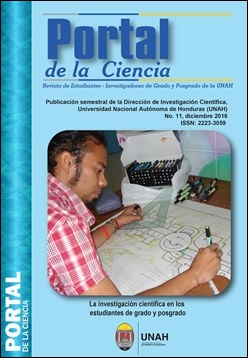Laryngeal Cancer and Human Papillomavirus in adults at Hospital Escuela Universitario, Honduras
DOI:
https://doi.org/10.5377/pc.v11i0.4265Keywords:
Laryngeal neoplasm, Human Papillomavirus, PCRAbstract
Introduction: laryngeal cancer is the most frequent in head and neck, recently HPV is involved in its carcinogenesis. Objective: To identify the presence of human papillomavirus (HPV) in patients with larynx carcinoma at HEU from March 2012 until March 2015.
Methods: A retrospective study was performed. Under authorization of the Pathology Department, the histopathological studies from patients already diagnosed having laryngeal carcinoma during the period from March 2012- March 2015 were reviewed. A universe of 91 patients with larynx carcinoma was obtained. In the selected 30 patients whose specimens were preserved in paraffin blocks, HPV DNA identification by polymerase chain reaction (PCR) followed by molecular genotyping using hybridization probes by reverse LIPA (INMO - LIPA HPV Genotyping Extra) were accomplished.
Results: Gender distribution: 26/30 (86.6 %) men and 4/30 (13.3 %) women with a mean age of 62.7 yearsin HVP positive patients was 54.8 years .Coming largely from the rural areas19/30(63.3 %). The risk co-factors identified weresmoking22/30(73.3 %) and alcoholism 20/30(66.6 %).The most affected anatomic site: the glottis 16/30 (53.3 %). Histologically prevailed in 21/30 (70 %) of patients moderately differentiated squamous cell carcinoma. Most patients were in stage III12/30(40 %) at the diagnosis time, (p=0.09).HPV prevalence was 13/30(43.3%), IC95% (25.5-62.6), p<0.001. High risk genotypes (16, 31, 33, 51, 52, 53, 56, 58), as well as low risk (6, 11, 71 and 74) were identified. Non-oncogenic HPV 11 (23%) was the most frequent type encountered and the oncogenic HPV 16 (15.4%). Co-infection was noted with two or more genotypes.
Conclusions: Prevalence HPV was 43.3%. HPV 11 and 16 were the most frequent. Due to a reduce sample and results variability among international studies, it is not possible to establish a clear association between HPV and laryngeal cancer. Further studies with more representative sample are required and recommended.
Revista Portal de la Ciencia, No.11, diciembre 2016, 40-53
Downloads
2122
Downloads
Published
How to Cite
Issue
Section
License
© Revista Portal de la Ciencia
Los autores/as que publiquen en esta revista aceptan las siguientes condiciones:
De acuerdo con la legislación de derechos de autor, Revista Portal de la Ciencia, reconoce y respeta el derecho moral de los autores, así como la titularidad del derecho patrimonial, el cual será cedido a la revista para su difusión en acceso abierto en versión impresa y en formato digital. Al formar parte de múltiples indexadores, bases de datos y sistemas de referencia, los artículos que sean publicados por Revista Portal de la Ciencia se encontrarán visibles y serán descargados también de estos sitios web, indicando, en todos los casos, la autoría de los artículos, la fecha de publicación y el número de la revista al que corresponden.

Este obra está bajo una licencia de Creative Commons Reconocimiento-NoComercial 4.0 Internacional.
Usted está en libertad de:
- Compartir: copiar y redistribuir el material en cualquier medio o formato
- Adaptar: remezclar, transformar y crear a partir del material
Bajo las siguientes condiciones:
- Reconocimiento: Usted debe darle crédito a esta obra de manera adecuada, proporcionando un enlace a la licencia, e indicando si se han realizado cambios. Puede hacerlo en cualquier forma razonable, pero no de forma tal que sugiera que usted o su uso tienen el apoyo del licenciante.
- Uso no comercial: Usted no puede hacer uso del material con fines comerciales.




